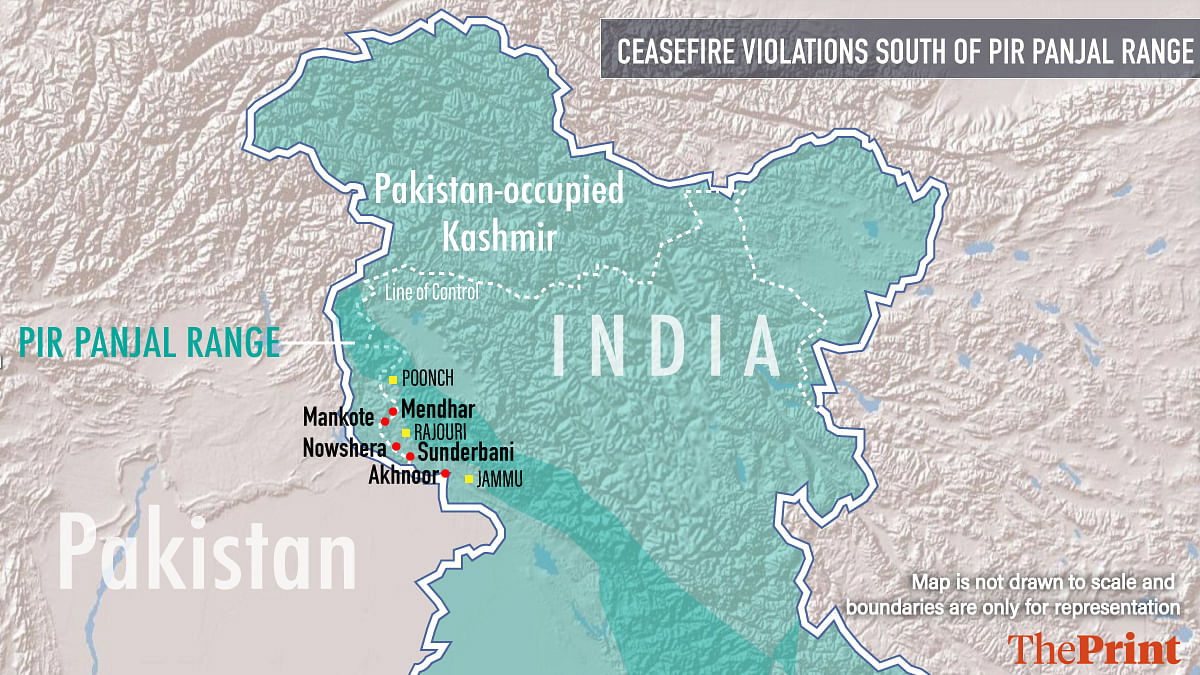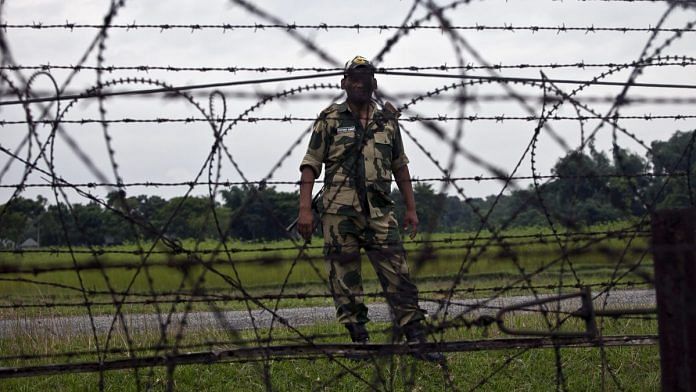New Delhi: Virtually every day, there are reports of attacks in the Kashmir Valley. Militants — some local, some from across the Line of Control — perpetrate violence against civilians and security forces, leaving behind a trail of destruction and despair.
But the Valley is not the only region in Jammu and Kashmir that is targeted by Pakistan — whether through its army or proxies. The districts of Poonch, Rajouri and Jammu, located south and west of the Pir Panjal mountain range that separate them from the Valley, witness as much if not more destruction, thanks to heavy and sustained targeting by the Pakistani military.
Defence Minister Nirmala Sitharaman had recognised the trend last year when she said that Pakistan was extending its “arc of terror” to areas south of the Pir Panjal, and was increasingly resorting to ceasefire violations to help infiltration in the area. Security measures, she said, were being beefed up in the region.
Record ceasefire violations and shelling
Over the last few years, the 2003 ceasefire agreement between India and Pakistan has been violated several times a month, with Pakistani artillery and heavy weapons striking these districts and leaving a trail of dead and injured persons and rubble in their wake. The difference is that there is hardly any terror on the ground in these districts — it’s all firing and shelling from the other side of the LoC.

J&K recorded 2,936 cases of ceasefire violations by Pakistan in 2018 alone. Top defence sources told ThePrint that of the total number of shelling and firing incidents across the LoC, roughly 15 per cent take place in Uri and Baramulla areas in the Kashmir Valley, while approximately 40 per cent of the cases take place in Poonch district, particularly in Kerni and Krishna Ghati sectors, about 35 per cent takes place in the Rajouri sector, particularly Nowshera, Kalal and Sunderbani sectors, and about 10 per cent of the incidents take place in the Akhnoor sector of Jammu district.
Since February, a five-year-old girl, an Army major, a BSF official and many other soldiers have been killed in the shelling in Poonch, Rajouri and Jammu. Even the 27 February air battle between the Indian and Pakistani air forces took place over Nowshera.
Also read: An adversary India has paid little attention to: Pakistan army’s public relations wing
Why is this area targeted?
Geographically, the altitude gets lower as one moves from the north of the Pir Panjal range to the south. While there is substantial forest cover on either side, there is more habitation to the south and less trees there. The terrain is also interspersed with a large number of nullahs or mountain streams.
On the other side of the LoC, in Pakistan-occupied Kashmir, the terrain gradually flattens out towards Khuiratta, allowing Pakistan’s massive artillery weapons easy access.
This is an area Pakistan has traditionally targeted because of two key reasons, according to officers of the Indian military who have served there. One is the fact that the two main roads of the state pass through this region — the Jammu-Srinagar highway and the road from Jammu to Poonch, which connects to the Mughal Road between Poonch and Shopian in the Valley via the Pir Panjal Pass.
It’s a strategic corridor, and if hit, it can significantly impact not just the security establishment but also the local population.
There is also a demographic factor at play here — the population of Hindus increases as one goes southwards — from 3.04 per cent in Baramulla district in north Kashmir to 6.84 per cent in Poonch, 34.54 per cent in Rajouri and 84.27 per cent in Jammu, as per the 2011 Census. The Akhnoor sector in Jammu has a 92.37 per cent Hindu population.
These border districts do have a high Muslim population, but experts point out that there are social and cultural differences between them and the Muslims of the Kashmir Valley. The Muslims in this region belong to the Gujjar and Bakerwal nomadic communities, and have traditionally drawn less sympathy and attention from the Pakistani establishment than the Muslims of the Valley.
Lt Gen. (retd) D.S. Hooda, former Northern Army Commander and the man who led the surgical strikes across the LoC in 2016, said Pakistan also wants to float a certain narrative by keeping this area under constant duress. The demographic constitution of the population in Nowshera and Akhnoor also plays its part in Pakistan’s strategy, he added.
“They (Pakistan) know that displacement of the Hindu population will effectively put pressure on the government,” he told ThePrint.
“They want to project that it is not just the Kashmir Valley which is disturbed, but that the whole state is in constant turmoil. The idea is to keep the LoC activated by constantly sneaking in and attempting to cause some casualties on some Indian patrols. The terrain of these areas makes it easier,” said Hooda.
“It is not just ceasefire violations which keep the area disturbed. There have been several instances of sniping and incidents where proxies from the other side have crossed over, planted IEDs and escaped.”
Battle for strategic advantage
Areas like Nowshera are important because of the constant battle for heights.
“We dominate most heights, with some exceptions in the Poonch region,” a senior Army official serving in one of these areas told ThePrint on the condition of anonymity.
“If they get domination, they can attempt cutting off the main road and target establishments like the brigade headquarters, ammunition and fuel dumps. It is difficult to sustain a war if the logistics chain is broken,” the official said, adding that crucial brigades and divisions of the Army are close to the LoC in these areas.
“A reason why these sectors remain more active than the others is because the Indian troops dominate most of the bulges in these areas, which ingress into Pakistan. When you are dominating a bulge ingressing into your enemy territory, you are exposed from all sides, hence there are more attacks,” said another senior Army official who has served in the area.
Lt Gen. (retd) Satish Dua, who commanded the crucial 15 Corps in Srinagar, added that the topographic factors “favour year-round skirmishes”.
“Many infiltrators also get easily absorbed into the local populace,” he said, adding that this leads to the scaling up of tensions in the region.
These areas have also witnessed several minefield casualties — owing to mines laid in previous wars which have drifted over the years with the rain and snow.
What history teaches us about the region
Military historian Mandeep Singh Bajwa said problems in these areas could be traced back to the 1948 war between India and Pakistan, where forces sponsored by the latter suffered losses.
“This area strikes a raw nerve for them. But they have an advantage — the Haji Pir bulge north of Poonch,” Bajwa said.
History also points out the strategic importance of the Chamb area, which was invaded by the Pakistan Army during both the 1965 and 1971 wars. However, the troops were stopped at the Tawi river — had they crossed it and taken over Akhnoor, they would have been able to disconnect Kashmir from Jammu and the rest of India.
The turmoil in these areas began after 1993, when there was a consensus among the Pakistan establishment to extend terror to these lower areas.
A former civil servant who served in the region said before militancy peaked in the Valley, people would even cross over the LoC for weddings. “The same family would be staying on either side of the LoC. But it changed with the rise of militancy in Kashmir, when the tensions spread to the southern parts of Pir Panjal,” he said.
“Many militants from the other side took refuge in and around the Pir Panjal region and got mixed with the local population under threat.”
Subsequently, in 2003, the Indian Army launched operation ‘Sarp Vinash’ to destroy terrorist bases in the Hilkaka, Poonch and Surankot areas.
Also read: Why Modi doesn’t mention the Dalai Lama anymore, while he rages against ‘enemy Pakistan’
Cycle of firing
Major General Umong Sethi, who served with the Northern Army Command, also said the low altitude, riverine terrains, and the weather conditions as well as closer targets for the forces contributed to the current dynamics of the region.
“Army firing from either side leads to retaliation. This cycle continues. Also, with more concentration of troops, when you hit a military target, there will be casualties,” he said.
Bajwa agreed, saying that because of the lower altitude, the enemy posts could be seen clearly, leading to a tendency among the troops to get into a cycle of firing.
“There is often a tendency to open fire at the enemy posts when they are seen at such close proximity,” Bajwa said, adding that eyeball-to-eyeball confrontation within visual range leads to increased chances of stressed soldiers opening fire at each other.
Sethi also said it is important to take into account the elevation of the bulges along the LoC and their control as far as military dominance is concerned.
“There are historical, geographical and demographic factors which support a constant proxy war,” he said.



